High Impact Tutoring Built By Math Experts
Personalized standards-aligned one-on-one math tutoring for schools and districts
In order to access this I need to be confident with:
2D shapes Polygons Types of angles Angles of a triangle Equilateral triangles QuadrilateralsAngles of a hexagon
Here you will learn about angles of a hexagon, including finding the sum of the interior angles and solving problems involving interior angles and exterior angles.
Students will first learn about angles of a hexagon as part of geometry in high school.
What are angles of a hexagon?
Angles of a hexagon are the angles in a six-sided polygon (2D shape).
There are different types of hexagons:
- A regular hexagon has six equal side lengths, six vertices, and six equal interior angles.

- An irregular hexagon has 6 sides which are not all equal, and 6 interior angles which are not all equal.

The sum of all interior angles of a hexagon is 720^{\circ}.
The sum of all exterior angles of a hexagon is 360^{\circ}.
![[FREE] Angles Check for Understanding Quiz (Grade 4)](https://thirdspacelearning.com/wp-content/uploads/2023/08/Angles-check-for-understanding-quiz-listing-image.png)
[FREE] Angles Check for Understanding Quiz (Grade 4)
![[FREE] Angles Check for Understanding Quiz (Grade 4)](https://thirdspacelearning.com/wp-content/uploads/2023/08/Angles-check-for-understanding-quiz-listing-image.png)
Use this quiz to check your grade 4 students’ understanding of angles. 10+ questions with answers covering a range of 4th grade angles topics to identify areas of strength and support!
DOWNLOAD FREE![[FREE] Angles Check for Understanding Quiz (Grade 4)](https://thirdspacelearning.com/wp-content/uploads/2023/08/Angles-check-for-understanding-quiz-listing-image.png)
[FREE] Angles Check for Understanding Quiz (Grade 4)
![[FREE] Angles Check for Understanding Quiz (Grade 4)](https://thirdspacelearning.com/wp-content/uploads/2023/08/Angles-check-for-understanding-quiz-listing-image.png)
Use this quiz to check your grade 4 students’ understanding of angles. 10+ questions with answers covering a range of 4th grade angles topics to identify areas of strength and support!
DOWNLOAD FREEInterior and exterior angles of a hexagon
We need to be able to solve problems involving angles of a hexagon.
To do this, you need to work with the interior and exterior angles of a hexagon.
A pair of interior and exterior angles of any polygon add to 180^{\circ} because they form a straight line. They are supplementary angles.
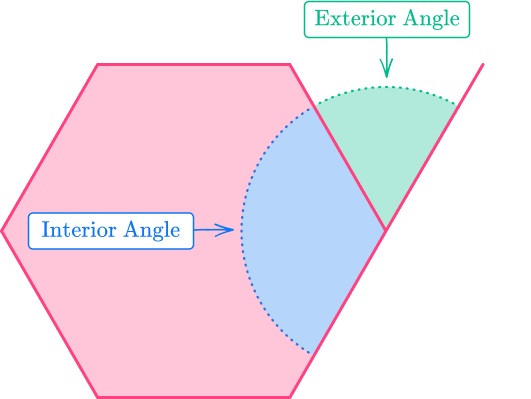
- Interior angles of a hexagon are the angles inside the 2D shape, formed when two sides of the shape meet.
We can find the sum of the interior angles of a hexagon, labeled I, by using the formula:
I=(n-2)\times{180}, where n is the number of sides.
A hexagon has 6 sides, so n=6.
\begin{aligned}I&=(6-2)\times{180} \\\\ &=4\times{180} \\\\ &=720^{\circ} \end{aligned}
The formula above uses the relationship between the angles in a triangle and the number of triangles a polygon can be split into.

To find an interior angle of a regular hexagon, you can divide the sum of the interior angles by the number of sides, in this case, 6.
Step-by-step guide: Interior angles of a polygon
- Exterior angles of a hexagon are the angles between the hexagon and the extended line from the next side.
The sum of the exterior angles of any polygon is always 360^{\circ}. To find each of the exterior angles of a regular hexagon, labeled E, you can use the formula
E=\cfrac{360}{n},
where n is the number of sides.
For a regular hexagon, n=6 so E=360\div{6}=60^{\circ}
Alternatively, if you know the size of the exterior angle of a polygon, you can use a rearrangement of the above formula to identify the number of sides the polygon has
n=\cfrac{360}{E}Step-by-step guide: Sum of exterior angles of a polygon
What are angles of a hexagon?
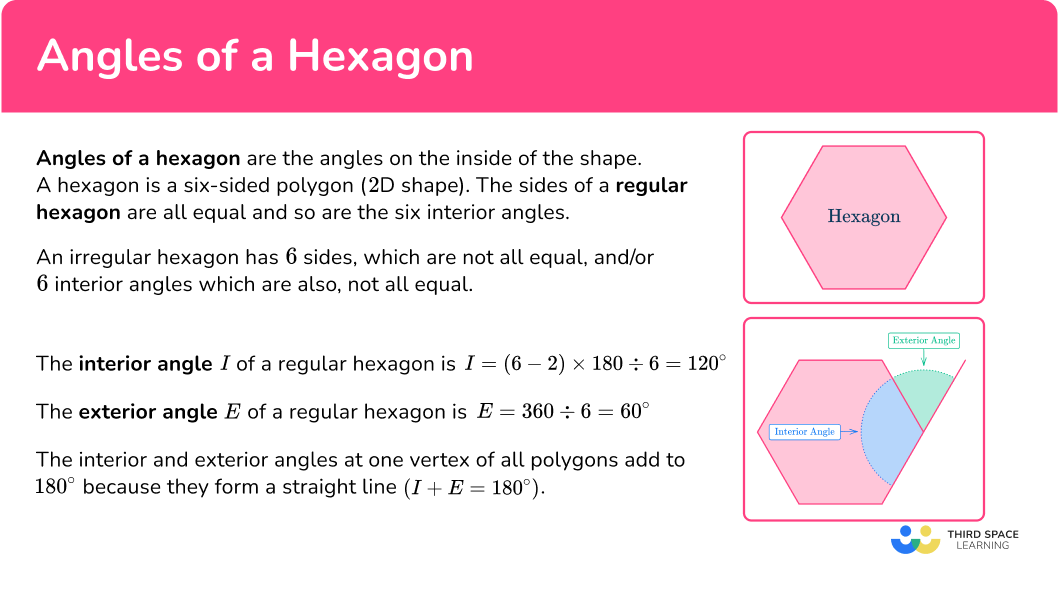
Common Core State Standards
How does this relate to high school math?
- High school – Geometry – Congruence (H.G.CO.C.10)
Prove theorems about triangles. Theorems include: measures of interior angles of a triangle sum to 180^{\circ}\text{;} base angles of isosceles triangles are congruent; the segment joining midpoints of two sides of a triangle is parallel to the third side and half the length; the medians of a triangle meet at a point.
How to solve problems involving angles of a hexagon
In order to solve problems involving angles of a hexagon:
- Identify if the hexagon is regular or irregular.
- Identify what the question is asking for.
- Solve the problem using the information you have gathered.
Angles of a hexagon examples
Example 1: finding the exterior angle of a regular hexagon
Below is a regular hexagon. Find the angle marked x.

- Identify if the hexagon is regular or irregular.
The question tells you that this is a regular hexagon. This means the sides of the hexagon are equal and the interior angles are equal.
2Identify what the question is asking for.
The question wants you to find the angle x, which is one of the six exterior angles of this hexagon.
3Solve the problem using the information you have gathered.
To find the size of the exterior angles of a regular hexagon you can use the formula
E=\cfrac{360}{n}, where n is the number of sides.
So, the missing angle can be calculated as
x=\cfrac{360}{6}=60^{\circ}.So, the exterior angle of a regular hexagon is 60^{\circ}.
Example 2: finding the sum of the interior angles of a hexagon
What is the sum of the interior angles of a hexagon?
Identify if the hexagon is regular or irregular.
The sum of the interior angles of a hexagon will be the same whether it is a regular or irregular hexagon.
Identify what the question is asking for.
The question asks you to calculate the sum of the internal angles of a hexagon.
Solve the problem using the information you have gathered.
To calculate the sum of the interior angles of a hexagon,
I=(n-2)\times{180}, where n is the number of sides.
So, the interior angle of a hexagon is
Example 3: finding an interior angle of a regular hexagon
Below is a regular hexagon shape. Find the angle marked x.

Identify if the hexagon is regular or irregular.
The question tells us that this is a regular hexagon.
Identify what the question is asking for.
The question wants us to find the angle x, which is one of the six interior angles of this hexagon.
Solve the problem using the information you have gathered.
To find the size of an interior angle of any hexagon, you need to calculate the sum of the interior angles first.
To calculate the sum of the interior angles of any polygon, you can use the formula
I=(n-2)\times{180}, where n is the number of sides.
So, the interior angle of a hexagon can be calculated as
Now that you know the angles inside a hexagon add up to 720^{\circ}, you can divide this by the number of sides, in this case 6, to find the size of one interior angle.
So, the missing angle can be calculated as
x=\cfrac{720}{6}=120^{\circ}.
Example 4: finding an interior angle of an irregular hexagon
Below is a polygon. Find the size of the missing angle x.
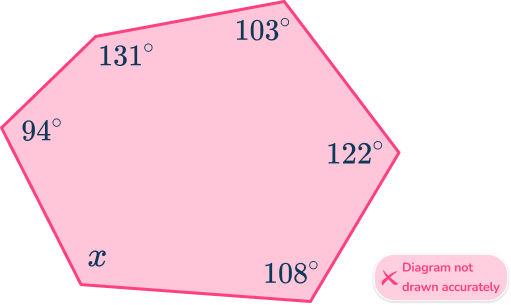
Identify if the hexagon is regular or irregular.
The interior angles of the hexagon are not equal, so it must be irregular.
Identify what the question is asking for.
The question asks you to find the missing interior angle.
Solve the problem using the information you have gathered.
The sum of interior angles for a hexagon is 720^{\circ}.
Next, subtract the interior angles you know to find the missing value.
x=720-(94+131+103+122+108)=162^{\circ}.
Example 5: finding an exterior angle of an irregular hexagon
Below is an irregular polygon. Find the size of the missing angle x.
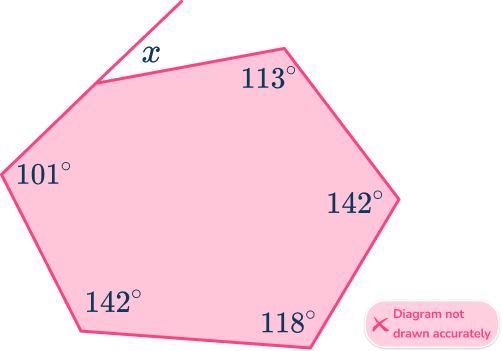
Identify if the hexagon is regular or irregular.
The question states that the polygon is irregular.
Identify what the question is asking for.
The question asks you to find the missing exterior angle.
Solve the problem using the information you have gathered.
To find the size of the exterior angle, x, you need to find the missing interior angle that corresponds to it, labeled y on the diagram below.
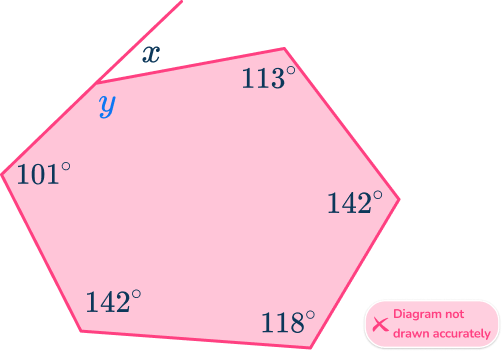
The sum of interior angles for a hexagon is 720^{\circ}.
Next, subtract the interior angles you know to find the missing value.
x=720-(101+142+118+142+113)=104^{\circ}
Now that you know the value of the interior angle corresponding to x, you can use the fact that the interior and exterior angles of all polygons add to 180^{\circ} because they form a straight line, to calculate the exterior angle.
So, x=180-104=76^{\circ}.
Example 6: solving angle problems involving hexagons
The diagram shows a tessellation from a section of floor tiles.
The shape is formed by two regular polygons.
Find the size of the angle labeled x.

Identify if the hexagon is regular or irregular.
The question states that both polygons in the diagram are regular polygons.
Identify what the question is asking for.
The questions asks us to find the size of the angle x, which is formed on the exterior of the two regular hexagons.
Solve the problem using the information you have gathered.
To find the size of the angle, x, you need to find the missing interior angles that meet it at the point.
The sum of interior angles for a hexagon is 720^{\circ}.
Next, divide this by the number of sides, in this case 6, to find the size of one of the interior angles.
\cfrac{720}{6}=120^{\circ}
Now that you know that the two interior angles are 120^{\circ} each, you can use the angle fact ‘angles around a point add up to 360^{\circ} ’ to find the angle x.
So, x=360-(120+120)=120^{\circ}.
Teaching tips for angles of a hexagon
- Show examples of hexagons in real life, such as honeycombs, tiles, and nuts/bolts.
- Ensure that students have a strong understanding of the properties of hexagons. Mention that they can be regular (equal angles and equal lengths) or irregular. Discuss specific types such as concave hexagons and convex hexagons. Review concepts such as the area of a regular hexagon and perimeter of a regular hexagon.
- Provide quizzes and worksheets to test understanding, with a mix of multiple-choice, short answer, and drawing problems. Utilize math tutors as needed.
- Have students use calculators to verify calculations with both regular and irregular hexagons.
Easy mistakes to make
- Not identifying regular and irregular polygons
It is important to correctly identify whether a polygon is regular or irregular, using the information given in the question or on the diagram. Do not assume one or the other.
- Using the formulae incorrectly
Whether a polygon is regular or irregular will determine how the formulae for working with interior and exterior angles can be used.
For example, the formula E=\cfrac{360}{n}, where n is the number of sides.
It can only be used to find the size of exterior angles of regular polygons, where all exterior angles are equal.
Related angles in polygons lessons
- Interior and exterior angles of polygons
- Quadrilateral angles
Practice angles of a hexagon questions
1. Calculate the exterior angle of a regular hexagon.




We can find the size of an exterior angle of any regular polygon using the formula
E=\cfrac{360}{n}, where n is the number of sides.
So, the size of exterior angles of a regular hexagon can be calculated as \cfrac{360}{6}=60^{\circ}.
2. Calculate the sum of the interior angles of a 6 sided polygon.




We can find the sum of the interior angles of any polygon using the formula
I=(n-2)\times{180}, where n is the number of sides.
As n=6
\begin{aligned}I&=(6-2)\times{180} \\\\ &=4\times{180} \\\\ &=720^{\circ} \end{aligned}
3. The diagram shows a hexagon. Calculate the missing angle x.
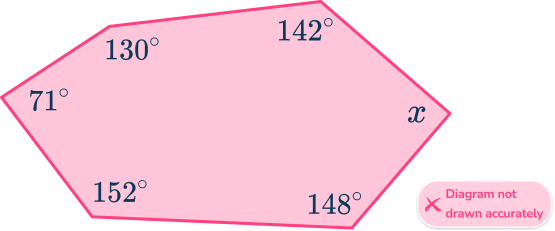




To find the value of one interior angle of an irregular polygon, you first need to calculate the sum of the interior angles of the polygon.
We can find the sum of the interior angles of any polygon using the formula
I=(n-2)\times{180}, where n is the number of sides.
I=(6-2)\times{180}=720^{\circ}
Now that you know the angles inside the hexagon add up to 720^{\circ}, you can subtract the interior angles you know to find the missing value.
x=720-(142+130+71+152+148)=77^{\circ}
4. The diagram shows a hexagon. Calculate the missing angle x.
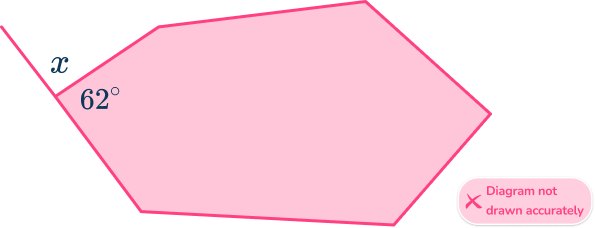




The interior and exterior angles of any polygon at a vertex add up to 180^{\circ}, so, x=180-62=118^{\circ}.
5. The diagram shows a hexagon. Calculate the missing angle x.
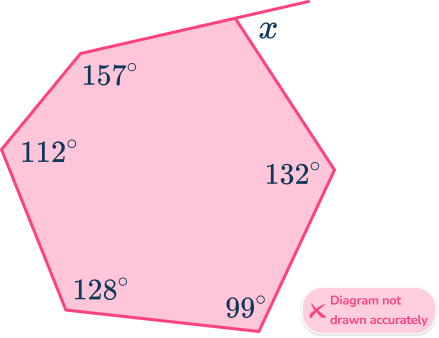




The sum of interior angles for a hexagon is 720^{\circ}.
Subtract the interior angles you know to find the missing value.
y=720-(157+112+128+99+132)=92^{\circ}
6. Two regular polygons meet at a vertex forming two triangles between them. Find the size of the missing angle x.
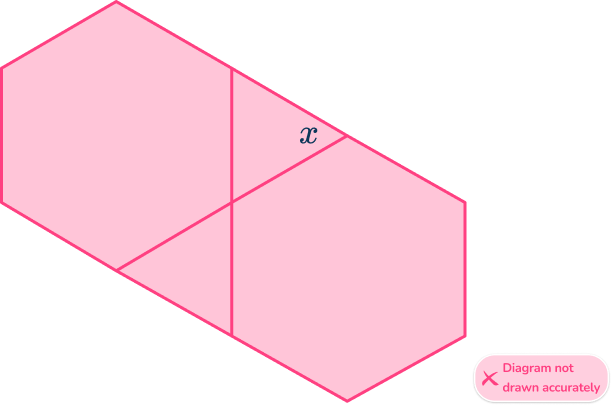




Each exterior angle of a regular hexagon is \cfrac{360}{6}=60^{\circ}.
Angles of a hexagon FAQs
The sum of the interior angles of a hexagon is 720^{\circ}.
In a regular hexagon, where all interior angles are equal, each interior angle measures 120^{\circ}.
The sum of the exterior angles of any polygon, including a hexagon, is always 360^{\circ}.
In a regular hexagon, where all exterior angles are equal, each exterior angle measures 60^{\circ}.
In a regular hexagon, the six lines of symmetry ensure all interior (120^{\circ}) and exterior (60^{\circ}) angles are equal by dividing the hexagon into identical parts.
In irregular hexagons, lines of symmetry, if present, divide the shape and angles equally along the symmetry line.
The next lessons are
- Congruence and similarity
- Transformations
- Mathematical proof
Still stuck?
At Third Space Learning, we specialize in helping teachers and school leaders to provide personalized math support for more of their students through high-quality, online one-on-one math tutoring delivered by subject experts.
Each week, our tutors support thousands of students who are at risk of not meeting their grade-level expectations, and help accelerate their progress and boost their confidence.

Find out how we can help your students achieve success with our math tutoring programs.
[FREE] Common Core Practice Tests (3rd to 8th Grade)
Prepare for math tests in your state with these 3rd Grade to 8th Grade practice assessments for Common Core and state equivalents.
Get your 6 multiple choice practice tests with detailed answers to support test prep, created by US math teachers for US math teachers!